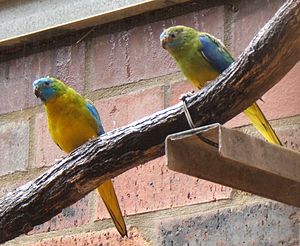- Turquoise Parrot
-
Turquoise Parrot 
Male (left) and female (right) at Rainbow Jungle, Australia Conservation status Scientific classification Kingdom: Animalia Phylum: Chordata Class: Aves Order: Psittaciformes Family: Psittacidae Subfamily: Platycercinae Tribe: Neophemini Genus: Neophema Species: N. pulchella Binomial name Neophema pulchella
(Shaw, 1792)The Turquoise Parrot (Neophema pulchella) is a parrot previously widespread in Eastern Australia, though now mainly found in northeastern New South Wales and north-eastern Victoria.
A small parrot at around 20 cm long, the male is predominantly green in colour and more yellowish below with a bright turquoise blue face and chestnut shoulders on the blue and green wings. Females are generally duller and paler and lack the chestnut wing patch.
It is found in grasslands and open woodlands, and feeds on grasses, seeds and nectar.
Contents
Taxonomy and naming
The English Common Name of the Turquoise Parrot been known alternately as Chestnut-shouldered parakeet, Chestnut-shouldered grass-parakeet,[1] Chestnut-shouldered Grass-parrot,[1] Chestnut-winged Grass-parakeet,[1] Chestnut-winged Grass-Parrot[1] and Turquoisine Grass Parrot.
Conservation status
Australia
It is not listed as threatened on the Commonwealth Environment Protection and Biodiversity Conservation Act 1999.
New South Wales
Once common in Western Sydney, it is listed as a Vulnerable species under Schedule 2 of the New South Wales Threatened Species Conservation Act, 1995 because of Habitat Destruction(TSC Act).
Victoria
- This species is listed as threatened on the Victorian Flora and Fauna Guarantee Act (1988).[1] Under this Act, an Action Statement for the recovery and future management of the Turquoise Parrot has not been prepared.[2]
- On the 2007 advisory list of threatened vertebrate fauna in Victoria, this species is listed as near threatened.[2]
Aviculture
Captive-bred birds adapt readily to aviary conditions, and the species is widely bred. Several colour forms are seen in captivity, including a yellow, red-fronted and pied form (all recessive), and jade and Olive (dominant).
Sundown NP, S.Queensland, Australia
References
- ^ a b c d MacDonald, J. D. (1987). The Illustrated Dictionary of Australian Birds by Common Name. Australia: Reed Books.
- ^ Victorian Department of Sustainability and Environment (2007). Advisory List of Threatened Vertebrate Fauna in Victoria - 2007. East Melbourne, Victoria: Department of Sustainability and Environment. p. 15. ISBN 978-1-74208-039-0.
Further reading
- Lendon AH (1980). Australian Parrots in Field and Aviary. Angus & Robertson. ISBN 0-207-12424-8.
External links
- BirdLife Species Factsheet.
- Birds in Backyards - Turquoise parrot
- Turquoise parrot, Vulnerable Species Listing
- Turquoise parrot, Threatened Species Listing
- IUCN Red List Classification: Neophema pulchella

This article relating to parrots is a stub. You can help Wikipedia by expanding it.


